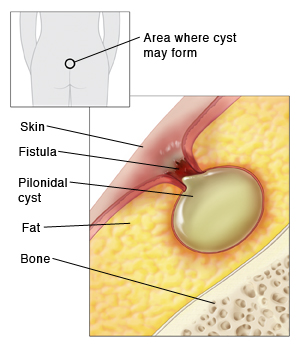Pilonidal Cyst
Pilonidal Cyst
A pilonidal cyst is found near the base of the spine (tailbone) or top of the buttocks crease. It may look like a pit or small depression. In some cases, it may have a hollow tunnel (sinus tract) that connects it to the surface of the skin. Normally, a pilonidal cyst does not cause symptoms. But if it becomes infected, it can cause pain and swelling.

What causes a pilonidal cyst and who gets them?
Two main causes are:
-
Ingrown hairs. This happens when a hair is forced under the skin or when a hair follicle ruptures.
-
Injury to the area. This can happen from sitting for long periods of time.
These cysts are often diagnosed in people between ages 16 and 26. But people of any age can have a pilonidal cyst. They affect both men and women, but they are more common in men.
Symptoms of a pilonidal cyst infection
A pilonidal cyst may not cause symptoms unless it becomes infected or inflamed. Once a pilonidal cyst becomes infected, it is called a pilonidal abscess. Infection or inflammation from irritation may cause the following symptoms:
-
Pain, redness, and swelling of the cyst and area around it
-
Foul-smelling drainage from the cyst
-
Fever
Diagnosing a pilonidal cyst
A pilonidal cyst can be diagnosed by how it looks and by its location. Your healthcare provider will examine the suspected cyst to confirm a diagnosis. You will be told if any tests are needed.
Treating a pilonidal cyst infection
Most pilonidal cysts are left alone. But if a cyst becomes infected or inflamed, you need treatment. It may include the following:
-
Incision and drainage. If needed, the cyst is cut open, and pus and other infected material is allowed to drain.
-
Antibiotic medicines for the infection. Know that medicines don't make the cyst go away, and antibiotics have limited use in treating an abscess. They also won’t keep a cyst from becoming infected again.
-
Hot water soaks. These can help draw out the infection and ease pain and itching.
-
Surgery to remove the cyst (excision). This may be done if the infection is severe, does not respond to medicine, or keeps coming back. A surgeon cuts and removes the cyst and the tissue around it. Your healthcare provider can tell you more if this is needed.
-
Laser hair removal around the area. This may decrease the frequency of flare-ups.
Preventing infection
A pilonidal cyst can easily become infected. The following to help prevent infections:
-
Keep the cyst and surrounding skin area clean.
-
Remove hair from the area of the cyst regularly. Ask your healthcare provider about safe hair removal products or procedures.
-
Don't sit in one position for long periods of time. This helps to reduce weight and pressure on your tailbone area. Sitting on a special cushion to relieve pressure on the tailbone may also help. Ask your healthcare provider about where to purchase these cushions.
-
Don't wear tight-fitting clothing to reduce skin irritation around the cyst.
Updated:
October 08, 2020
Sources:
Management of intragluteal pilonidal disease. UpToDate.
Reviewed By:
Michael Lehrer MD,Rita Sather RN,Raymond Kent Turley BSN MSN RN